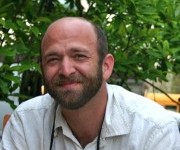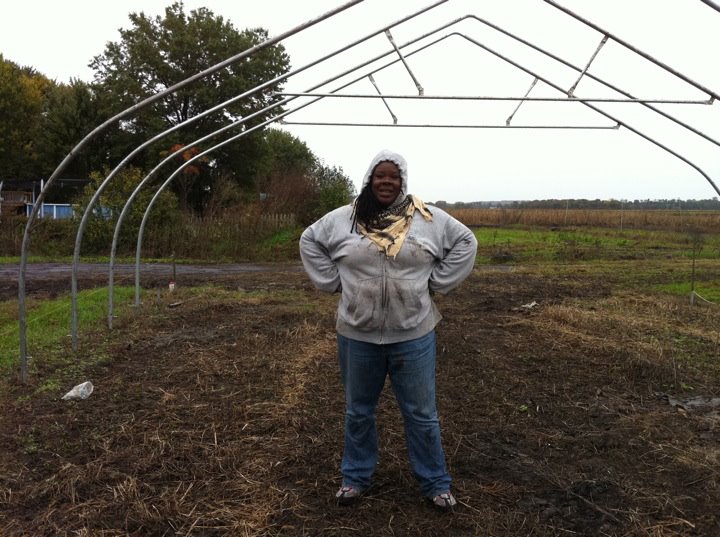Grist is proud to present the Change Gang — profiles of people who are leading change on the ground toward a more sustainable society and a greener planet. Some we’ve written about before; some are new to our pages. Some you’ll have heard of; most you probably won’t. Know someone we should add to the Change Gang? Tell us why.
 From the moment Alexi Arango walked into Professor Sue Carter’s physics lab as an undergraduate at U.C. Santa Cruz and started learning how to make his own photovoltaic solar cells, he was “hooked.”
From the moment Alexi Arango walked into Professor Sue Carter’s physics lab as an undergraduate at U.C. Santa Cruz and started learning how to make his own photovoltaic solar cells, he was “hooked.”
“It sounds really weird,” he acknowledges, “but it was just so exciting to me — on a real fundamental level — to be working with vacuum and semiconductor fabrication equipment.”
Throw in the added benefit of a technology that could “benefit the environment,” and Arango says he was “done.” He knew where he was headed. Today, after a PhD from MIT and a short stint at a digital ink startup, Arango is an assistant professor at Mount Holyoke, where he has put together his own state-of-the-art solar cell laboratory. Here he and his students are pushing at the farthest frontiers of material science, striving to determine if better, cheaper, more efficient solar cells can be built from exotic semiconductor materials like quantum dots and conjugated polymers.
A quantum dot, says Arango, is a “tiny nano-crystalline piece of semiconductor” with a very useful property: It can be printed. A conjugated polymer is a type of plastic that can actually conduct electricity.
The goal in experimenting with both substances is simple: finding ways to “coax” a sun-crazed electron to an electrode faster than ever before. It may be 10 or 20 years before solar cells built on the technologies Arango’s team are researching arrive in commercial products. But when they do, Arango says, they will be key steps in realizing solar power’s unmatchable potential to move humanity past its energy and climate crises.
In the gentlest possible way, the soft-spoken Arango scoffs at the idea that higher costs doom solar power from being economically competitive with electricity derived from burning fossil fuels. Worldwide, solar power energy capacity has been growing at 40 percent a year for a decade. One reason solar panels haven’t grown even faster is that they’re still so cumbersome to install.
“A lot of the cost,” says Arango, “goes into just putting up the panels on someone’s roof, figuring out what direction you are going to point them, hauling them up there, having to wire each one correctly.”
In the not-so-distant future, suggests Arango, we’ll be printing out sheets of solar cells as fast as your morning newspaper rolls off the press. (If you, er, still get one.) And then we’ll just unroll those sheets onto our roofs.
Arango acknowledges that some already existing “thin-film” solar panel startups in Silicon Valley are finding it hard to compete with state-subsidized Chinese solar cell manufacturers that have been flooding the U.S. market with cheap panels. But he’s convinced that we’re merely in the middle of a transition period. Ultimately, he thinks, economies of scale will kick in and start working for companies bringing next-generation technologies to market.
Despite the low retail costs, says Arango, “the type of technology that the Chinese are pursuing — crystalline silicon — is fundamentally more expensive. It is very labor intensive to manufacture.” As Chinese labor costs rise, they’ll have a harder time competing with thin-film manufacturers.
Of course, that’s little reason for complacency.
“The funding for both the fundamental research necessary for understanding how we will make better solar cells and batteries in the future, and the practical subsidies that are needed to build out the solar infrastructure and get it to the economies of scale where it can sustain itself — both of those things needed to happen 20 to 30 years ago,” says Arango. “It is insane that the level of research funding for solar is measured in the tens of millions, and for nuclear it’s in the billions, and for fighting disease it is in the tens of billions.”
“It is very difficult to argue against fighting cancer. But in terms of a priority of our research budget, you could fight quite effectively against global warming, and for the health of the human population, by investing in solar energy research.”



